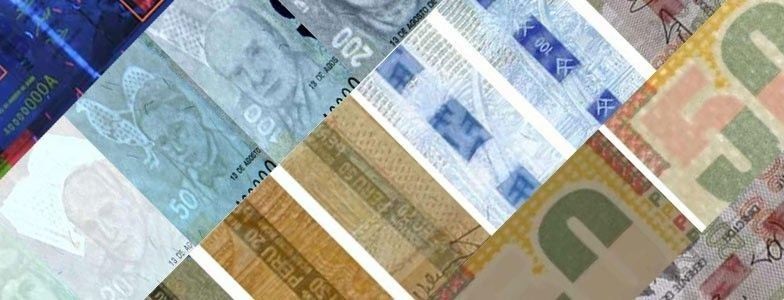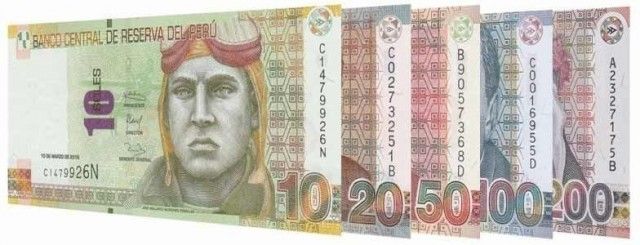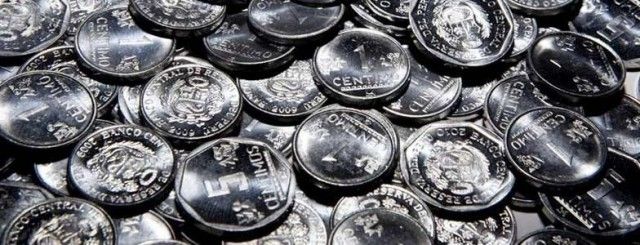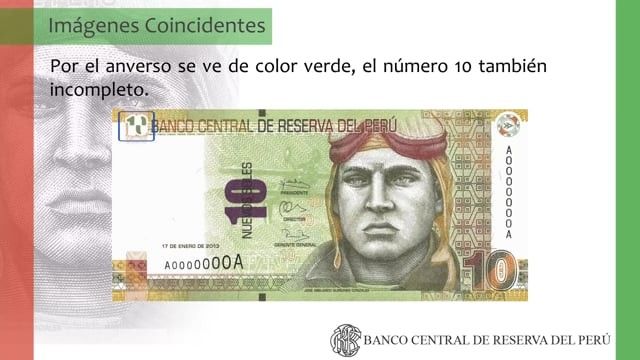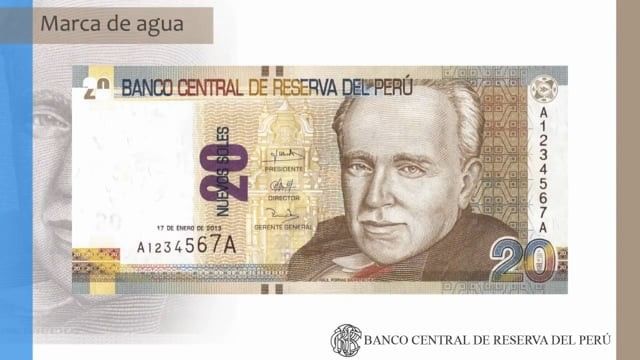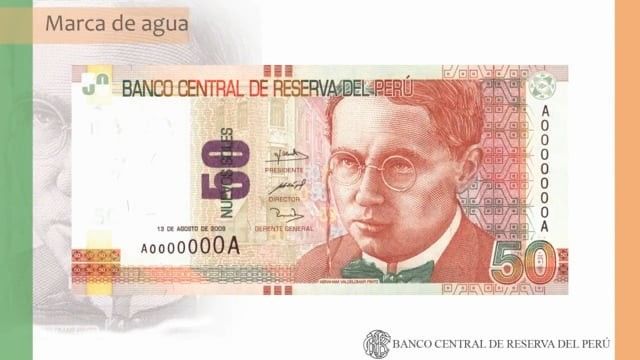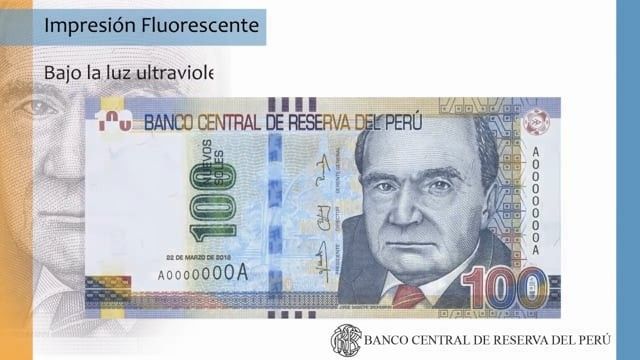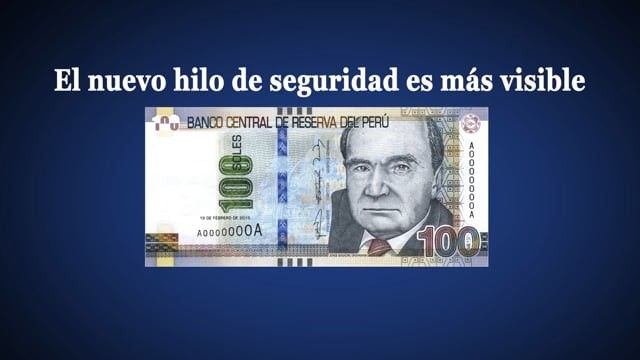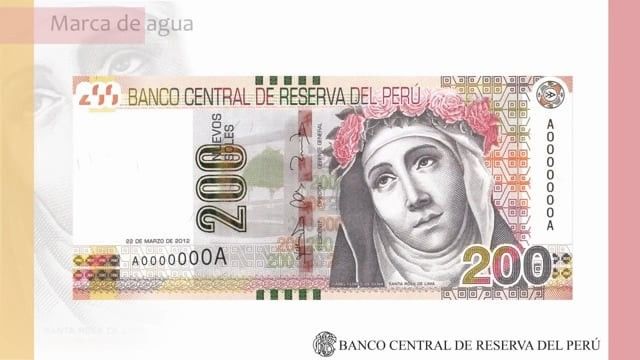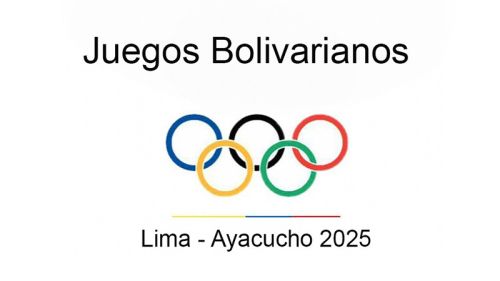Over the past decade Peru established itself as the world leader in counterfeit money output producing the world’s finest fake banknotes; mainly US Dollars – about 60% of all counterfeit US$ bills are produced in Peru - but as well Peruvian (Nuevos) Soles. So, when living or travelling in Peru chances are high that you come across one or another fake bill. Therefore, we recommend to always check the money you receive. But what to look for?
In 2011 the Peruvian Central Reserve Bank (BCRP) introduced completely new designed Peruvian Nuevos Soles banknotes (series 2009 – 2016) implementing worldwide established security features; with renaming the Peruvian currency from Nuevo Sol to just Sol, new Peruvian Soles bills with partly further improved security features were put into circulation since 2016.
All Peruvian banknotes have next to highly sophisticated security features which only can be found with a thorough examination as well similar, easy to spot security features making the process of verifying the authenticity of a bill a simple and quick task for everyone in every situation.
Before you continue, we highly recommend familiarizing yourself with the current Peruvian banknotes.
Feel, Look and Tilt method
So, how can you easily determine if a Peruvian banknote is real or fake? After introducing the Euro a new concept to check if a banknote is genuine or counterfeit went global. Today the so-called “Feel, Look and Tilt” method can not only apply to the Euro, but as well to many other currencies worldwide including the Peruvian (Nuevos) Soles allowing everyone to detect counterfeits at a glance.
Feel the banknote
Peruvian banknotes are made of 100% cotton, giving each bill a unique texture and strength. The banknotes aren’t entirely smooth. In certain areas (for example the words “Banco Central de la Reserva”, the short, black strip(s) on the top and bottom of each banknote or parts of the collar of the personalities) relief printing is used. So, when you run your finger along these areas you feel the raised ink.
This relief printing is also a tremendous help for the visually impaired. The short, black strips at the top and bottom of each Peruvian banknote, which are printed with a raised ink, allow them to identify the value of the note by touch only.
- The 10 (Nuevos) Soles note has one strip
- The 20 (Nuevos) Soles note has two strips
- The 50 Nuevos Soles note has three strips
- The 100 (Nuevos) Soles note has four strips
- The 200 Nuevos Soles note has five strips
Be aware that age and wear can change the feel and appearance of the bills and some security features might not be that clear anymore.
Look at the banknote
Easy to spot security features by just looking at a Peruvian banknote against the light include the watermark, which can be found on the blank area of the note, the security stripe nearly in the middle of each bill and the number alignment. These features are explained in detail below.
Tilt the banknote
Some security features are only visible when you tilt the bill. So, just move the banknote slowly up and down. The main number with the value of the note, for example, is printed with an optical variable ink and changes its color when turned. Or discover the latent image which hides in the personality's clothing. Or have a closer look at the security stripe of the 100 and 200 (Nuevos) Soles banknotes when turning them up and down a little. These features are explained as well in detail below.
Other security features of Peruvian banknotes which either need a magnifying glass or a UV light include microprinting and fluorescent features, which are explained as well below.
Security features of Peruvian banknotes
To avoid ending up with fake bills, we highly recommend familiarizing yourself with the security features of genuine Peruvian (Nuevos) Soles banknotes which are explained in detail below. To give you a general overview, we added some sample pictures. However, as some of the features are only visible when holding the note against a light source or when turning it, we highly recommend watching the videos published by the Peruvian Central Reserve Bank (BCRP) which be linked below. Even though the added text in the videos is in Spanish, the videos are self-explanatory and easy to understand when you have read our explanation below.
Watermark - Security features of Peruvian banknotes
If you hold the Peruvian banknotes against the light, a sharp and clear 3D, multi-tone watermark comprising three distinct areas appears on the blank area of the bill.
- The watermark of the 10 (Nuevos) Soles banknote comprises the number 10, an image of José Abelardo Quiñones Gonzáles and an airplane
- The watermark of the 20 (Nuevos) Soles banknote comprises the number 20, an image of Raúl Porras Barrenechea and a book
- The watermark of the 50 Nuevos Soles banknote comprises the number 50, an image of Abraham Valdelomar Pinto and a cock
- The watermark of the 100 (Nuevos) Soles banknote comprises the number 100, an image of Jorge Basadre Grohmann and the silhouette of the Peruvian National Flag
- The watermark of the 200 Nuevos Soles banknote comprises the number 200, an image of Saint Rose of Lima and an arcade
While the watermark on real bills is created by different paper thicknesses appearing as a multi-tone, three-dimensional image, the watermark on fake banknotes is just printed on, so it appears one-dimensional and blurry.
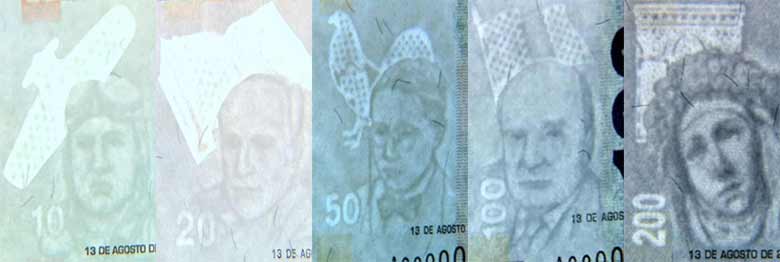
Security Stripe - Security features of Peruvian banknotes
The security stripe of the 10, 20 and 50 (Nuevos) Soles banknotes is inserted into the paper and can be found in the middle of the bill between the value of the denomination, so the 10, 20 or 50 and the image of the personality when holding the banknote against the light. Depending on the denomination of the banknote you can read on the stripe Peru 10, Peru 20 or Peru 50 and underneath three times BCRP (abbreviation of the Peruvian Central Reserve Bank).
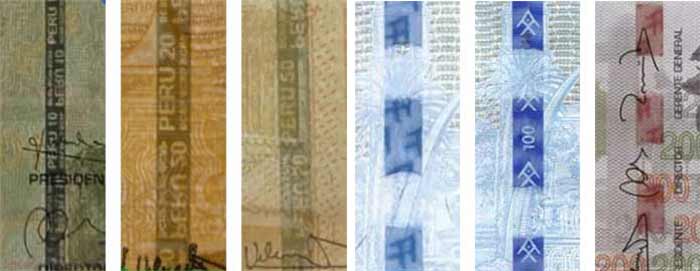
The security stripe of the 100 and 200 (Nuevos) Soles bills can be seen (at least partly) immediately when looking at the bill between the note’s value, 100 or 200, and the image of the personality. When moving the 100 and 200 Nuevos Soles banknote (series 2009 to 2016) up and down a little or left and right the small, stylized fishes on the visible part of the security stripe change their position. On the visible part of the new 100 Soles bill (series since 2016) the fish and the number 100 remain in the same position but the background moves. When holding a 100 or 200 (Nuevos) Soles banknote against the light, the visible part of security stripe appears clear and bright, while the part that is inserted into the paper seems just dark.
Number alignment - Security features of Peruvian banknotes
On the left upper corner of the front of each Peruvian bill you find the value of the denomination, so the number 10, 20, 50, 100 or 200, printed only partly in one color. In the upper right corner of the back the parts of the number from the front that appeared light are printed in another color. When holding the banknote against the light, the print from the front in one color and the print from the back in another color align perfectly and you see a completed number. On fake bills the different colors don’t align perfectly and often overlap.
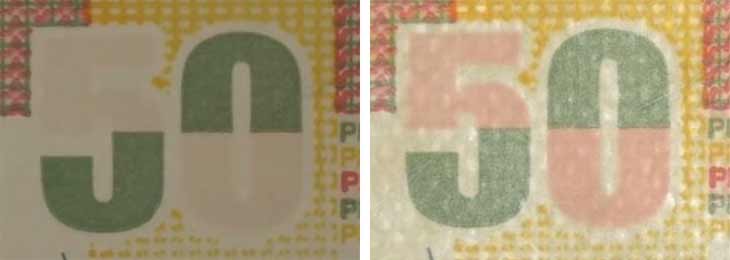
Optical variable ink - Security features of Peruvian banknotes
The denomination value, so the number 10, 20, 50, 100 or 200 to the left of the image of the personality on each Peruvian banknote is printed with an optical variable ink. So, when sliding the bill up and down the number changes its color.
on the 10 (Nuevos) Soles bill the 10 changes its color from fuchsia to green
on the 20 (Nuevos) Soles bill the 20 changes its color from fuchsia to green
on the 50 Nuevos Soles bill the 50 changes its color from fuchsia to green
On the 100 (Nuevos) Soles bill the 100 changes its color from green to blue
on the 200 Nuevos Soles bill the 200 changes its color from copper to green
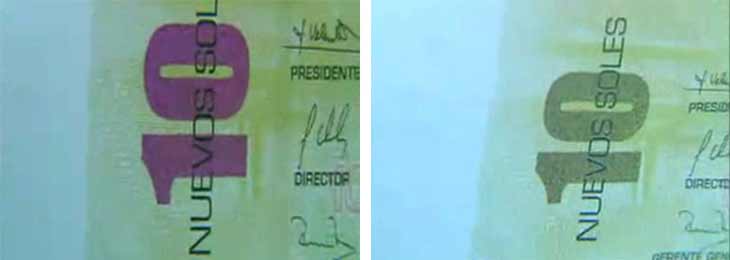
As it’s extremely difficult to replicate the optical variable ink, the number on a counterfeit banknote won’t change its color.
Latent image - Security features of Peruvian banknotes
Each banknote has the value of the denomination, so the number 10, 20, 50, 100 or 200, hidden in the personality's clothing. When looking at the note horizontally and moving it slowly up and down the note’s value of the 10, 20 and 50 (Nuevos) Soles bills appears under the left shoulder on the collar of the jacket. On the 100 (Nuevos) Soles note it appears under the right shoulder on the collar of the jacket and on the 200 Nuevos Soles bill on the veil next to the face.

Microprinting - Security features of Peruvian banknotes
Each Peruvian (Nuevos) Soles note (series 2009 – 2016 and series since 2016) has many areas on the front and back where microprinting is used. Invisible to the naked eye, the print can only be read with a magnifier. On the bottom part of the notes you can repeatedly find the note’s value, the word BCRP (abbreviation of the Peruvian Central Reserve Bank) and lovely geometrical figures. Microprinting as well can be found on the short, black strips on the top and bottom of each note.

Fluorescent Features - Security features of Peruvian banknotes
All Peruvian (Nuevos) Soles notes (series 2009 – 2016 and series since 2016) have many fluorescent fibers, areas, and ancient geometrical figures and images of artifacts that only appear under UV light.

Video explaining the security features of the 10 Nuevos Soles banknote
Video explaining the security features of the 20 Nuevos Soles banknote
Video explaining the security features of the 50 Nuevos Soles banknote
Video explaining the security features of the 100 Nuevos Soles banknote
Video explaining the new security stripe of the 100 Soles banknote
Video explaining the security features of the 200 Nuevos Soles banknote
Security features of Peruvian coins
Even though it seems not worth the effort, Peruvian forgers as well have discovered Peruvian coins, and here especially the 2 and 5 (Nuevos) Soles coins. So, when receiving change, not only examine bills but also coins.
Before you continue, we highly recommend familiarizing yourself with the Peruvian coins in circulation.
How can you determine if a Peruvian coin is real or just a fake?
No matter which coin you examine, all texts, numbers, images and lines should be clear, sharp and precise with no defects. Wear and tear of course take its toll on the coins; however, major defects and overall imprecise minting might show that a coin is fake.
One key area to look at is the back of the coin. Regardless of the value here you find the Peruvian Coat of Arms. It comprises the national shield (the Escudo Nacional) with a vicuña (Peru's national animal) on the upper left, a chinchona tree (native to the tropical Andes region and the source for the anti-malaria drug quinine) on the upper right and on the bottom a coin filled cornucopia. The shield is topped with a Holm Oak Civic Crown and surrounded by a palm branch on the left and a laurel branch on the right that is knotted together with a red and white ribbon.
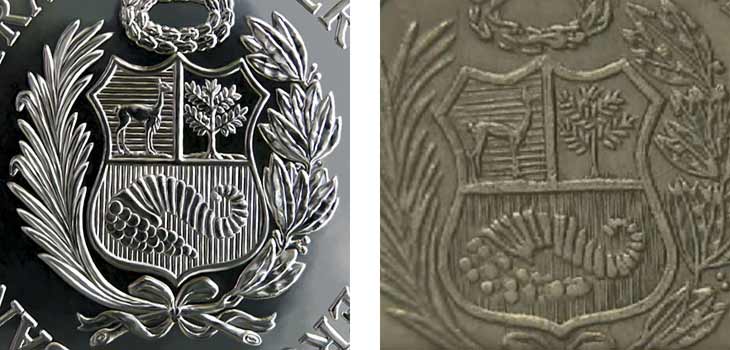
The horizontal lines behind the vicuña and the vertical lines behind the cornucopia should be parallel, straight, and evenly spaced. On fake coins, this isn’t the case.
The image of the vicuña, the tree and the cornucopia and the palm and laurel branch should be sharp, well-defined and clear, with no imperfections. On fake coins, they are usually imprecise.
The coins spilling out of the cornucopia should be plenty and connected. On fake coins they are separated, round and imperfect.
On the front of the bi-metallic 2 and 5 (Nuevos) Soles coins, the value, so the number 2 and 5 should continue without imperfection and misalignment from the inner to the outer ring and back. The same applies to the hummingbirds, the frigate bird and the geometrical lines.
For security features of US$ banknotes visit the website UScurrency.gov


